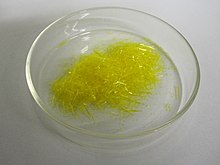Bombardier beetle
| Bombardier beetle | |
|---|---|

| |
| Brachinus species | |
| Scientific classification | |
| Domain: | Eukaryota |
| Kingdom: | Animalia |
| Phylum: | Arthropoda |
| Class: | Insecta |
| Order: | Coleoptera |
| Superfamily: | Caraboidea |
| Family: | Carabidae |
| Groups included | |
Bombardier beetles are
The spray is produced from a reaction between two
The beetle's unusual defense mechanism is claimed by some creationists to be an example of what they call irreducible complexity,[2] though this is refuted by evolutionary biologists.[3]
Habitat

Bombardier beetles inhabit all the continents except Antarctica.[4] They typically live in woodlands or grasslands in the temperate zones but can be found in other environments if there are moist places to lay their eggs.
Behavior
Most species of bombardier beetles are
Anatomy
There are two large glands that open at the tip of the abdomen. Each gland is composed of a thick walled vestibule which contains a mixture of catalases and peroxidases produced by the secretory cells that line the vestibule. Both glands are also made up of a thin-walled and compressible reservoir which contains an aqueous solution of hydroquinones and hydrogen peroxide.[1]
Mechanism of defense
When the beetle feels threatened it opens a valve which allows the aqueous solution from the reservoir to reach the vestibule. The catalases lining the vestibule wall facilitate the decomposition of hydrogen peroxide, as in the following theoretical reaction:
The peroxidase
The known net reaction, which further accounts for the theoretical reaction of the and products of the previous reactions, is:[1]

This reaction is very
The flow of reactants into the reaction chamber and subsequent ejection occur in a series of about 70 pulses, at a rate of about 500 pulses per second. The whole sequence of events takes only a fraction of a second. These pulsations are caused by repeated microexplosions which are the results of the continuous pressure on the reservoir and the oscillatory opening and closing of the valve that controls access to the reaction chamber. This pulsed mechanism is beneficial for the beetles' survival because the system uses pressure instead of muscles to eject the spray at a constant velocity, saving the beetle energy. Also, the reintroduction of new reactants into the vestibule where enzymes are stored, reduces the temperature of the chamber, thereby protecting the peroxidases and catalases from thermal denaturation.[8]
Typically the beetle turns its body so as to direct the jet towards whatever triggered the response. The gland openings of some African bombardier beetles can swivel through 270° and thrust between the insect's legs, discharging the fluid in a wide range of directions with considerable accuracy.[9]
Evolution of the defense mechanism
The unique combination of features of the bombardier beetle's defense mechanism—strongly exothermic reactions, boiling-hot fluids, and explosive release—has been claimed by creationists and proponents of intelligent design to be an example of irreducible complexity.[2]
Biologists such as the taxonomist Mark Isaak note however that step-by-step evolution of the mechanism could readily have occurred.
See also
References
- ^ S2CID 96158109.
- ^ ISBN 978-0-8160-5515-9.
- ^ a b Isaak, Mark (30 May 2003) [1997]. "Bombardier Beetles and the Argument of Design". TalkOrigins. Retrieved 3 August 2018.
- ^ "See the Amazing Way a Beetle Survives Being Eaten". National Geographic News. 2018-02-06. Archived from the original on August 8, 2020. Retrieved 2020-09-17.
- ^ "Bombardier Beetle". Animal Facts & Photos. Dallas Zoological Society. 2004. Archived from the original on 2011-07-08. Retrieved 2010-07-17.
- ^ Poetker, E. (2003). "Brachinus fumans". Animal Diversity Web.
- ^ Eisner & Aneshansley 1999
- PMID 2349480.
- ISBN 978-0-313-33922-6.
- YouTube — GrrlScientist (17 January 2011). "Irreducible complexity cut down to size". The Guardian.
This video specifically focuses on debunking the so-called "irreducible complexity" of the favourite examples used by creationists; the eye, the bombardier beetle, the venus flytrap and bacterial flagella.
- ^ a b Weber CG (Winter 1981). "The Bombardier Beetle Myth Exploded". Creation/Evolution. 2 (1). National Center for Science Education: 1–5.
- ^ a b Isaak, Mark (May 30, 2003). "Bombardier Beetles and the Argument of Design". TalkOrigins Archive.
- S2CID 4206540.
- PMID 10729276.
External links
- Eisner, T.; Aneshansley, D.J. (August 1999). "Spray aiming in the bombardier beetle: Photographic Evidence". Proc. Natl. Acad. Sci. U.S.A. 96 (17): 9705–9. PMID 10449758.
- Genus Brachinus — BugGuide.net
- Hesselberg T (6 November 2007). "Exploding beetles suggest a new pressure relief valve and fluid discharge system". Life of science.
- "Claim CB310: Bombardier beetle evolution". TalkOrigins Archive.
- Isaak, Mark (May 30, 2003). "Bombardier Beetles and the Argument of Design". TalkOrigins Archive.
- BBC (1999). "'Bull's-eye beetle' (Stenaptinus insignis)". BBC News.: 3 photos, 1 micrograph, 1 b/w illustration





